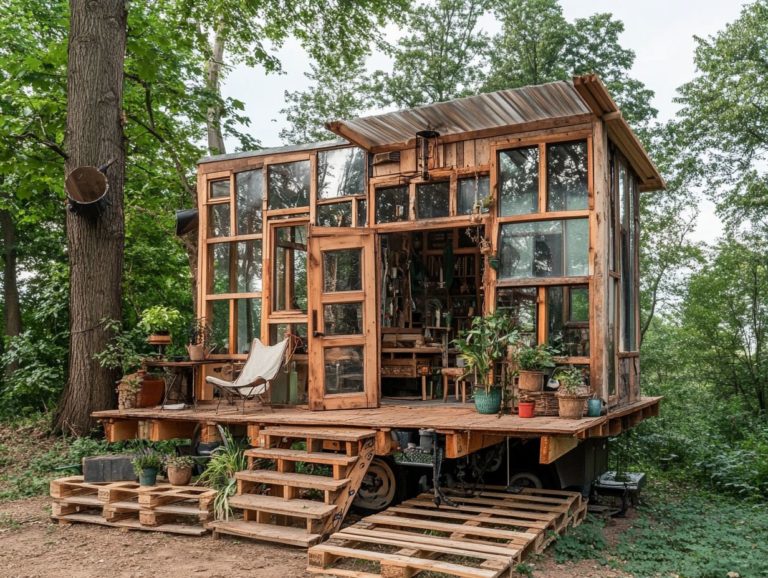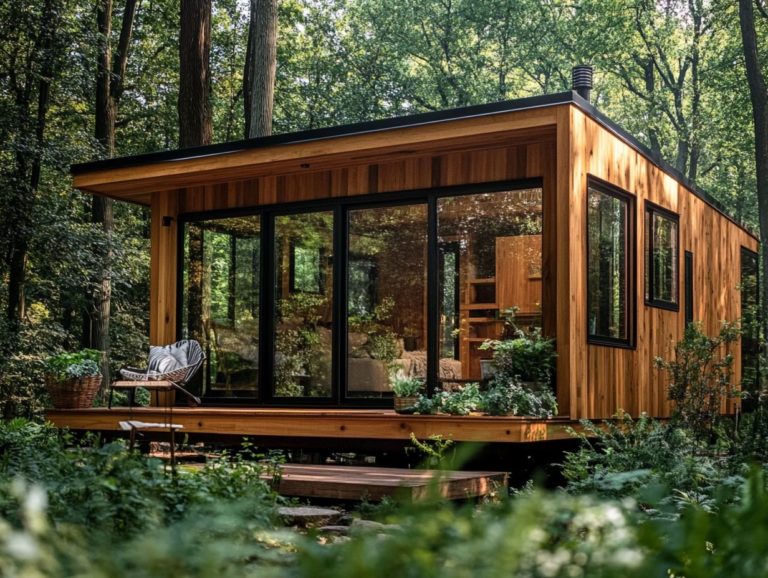Top 5 Sustainable Plumbing Materials for Tiny Houses
As the tiny house movement gains momentum, your quest for sustainable living becomes increasingly vital. One essential aspect of crafting an environmentally friendly small home lies in selecting the right plumbing materials.
This article delves into five innovative options:
- Recycled steel pipes
- Bamboo pipes
- Bio-composite pipes
- Copper pipes
- PEX pipes
Each material presents its own unique benefits and challenges, influencing durability, cost, and environmental responsibility.
Discover how these sustainable choices can transform your tiny house and play a crucial role in fostering a greener future!
Contents [hide]
- Key Takeaways:
- 1. Recycled Steel Pipes
- 2. Bamboo Pipes
- 3. Bio-Composite Pipes
- 4. Copper Pipes
- 5. PEX Pipes
- What Makes These Materials Sustainable for Tiny Houses?
- What Are the Pros and Cons of Each Material?
- How Do These Materials Compare in Terms of Durability and Cost?
- What Are the Environmental Benefits of Using These Materials?
- How Can Homeowners Properly Maintain and Repair These Sustainable Plumbing Materials?
- What Are the Long-Term Cost Savings of Using These Materials?
- Frequently Asked Questions
- What are the top 5 sustainable plumbing materials for tiny houses?
- How is bamboo a sustainable plumbing material for tiny houses?
- Why is recycled plastic a good choice for sustainable plumbing in tiny houses?
- What makes copper a sustainable option for tiny house plumbing?
- Why is PEX a popular sustainable plumbing material for tiny houses?
- How do composting toilets contribute to sustainable plumbing in tiny houses?
Key Takeaways:

- Incorporating sustainable plumbing materials, such as recycled steel pipes and bamboo pipes, can significantly reduce a tiny house’s environmental impact.
- When considering the pros and cons of materials like bio-composite and copper pipes, it’s important to weigh their durability and cost-effectiveness for long-term use.
- Using sustainable plumbing materials also leads to cost savings over time due to their longevity and lower maintenance needs.
1. Recycled Steel Pipes
Recycled steel pipes exemplify how you can seamlessly integrate sustainability into tiny house construction. They offer an environmentally friendly option that significantly reduces your home’s carbon footprint.
These pipes deliver exceptional durability and strength. By sourcing materials like reclaimed steel, you not only minimize reliance on virgin resources but also divert substantial amounts of waste from landfills. This approach plays a vital role in fostering a system where products are reused, repaired, and recycled.
When you incorporate recycled steel into your tiny house designs, its versatility allows for creative structural solutions, enhancing both aesthetic appeal and usefulness.
Utilizing these materials aligns perfectly with your commitment to sustainability. The combination of reduced waste and energy efficiency makes recycled steel an essential component in the pursuit of greener living spaces.
2. Bamboo Pipes
Bamboo pipes aren t just lightweight and strong; they also represent a sustainable choice that aligns with your commitment to eco-friendly living in tiny houses. This makes them an appealing option for homeowners like you who want to minimize their environmental footprint.
This remarkable material naturally resists moisture and can handle temperature fluctuations qualities essential for plumbing applications. By choosing bamboo, you re opting for a stylish solution while contributing to more sustainable building practices by reducing reliance on plastic and other less eco-friendly materials.
Incorporating bamboo pipes into your plumbing system enhances the aesthetic of your tiny home while supporting biodiversity through the promotion of this rapidly renewable resource. For those dedicated to an eco-conscious lifestyle, integrating bamboo into your plumbing strategies offers a practical solution that beautifully complements the minimalist ethos of tiny living.
3. Bio-Composite Pipes
Bio-composite pipes represent a revolutionary shift toward sustainable plumbing solutions, blending recycled materials with natural components. This creates an environmentally friendly option for tiny houses, significantly reducing your carbon footprint.
Designed to withstand wear and tear, these innovative pipes ensure longevity and lower replacement costs, making them a practical choice for you as a homeowner. Their eco-friendly composition not only mitigates environmental impact but also fosters healthier living conditions by minimizing the release of harmful chemicals.
As a tiny home dweller, you can truly appreciate the balance between functionality and ecological responsibility. The reduced reliance on traditional plastic options aligns perfectly with your philosophy of sustainable living. By choosing to incorporate these materials, you contribute significantly to the overarching goal of creating energy-efficient, low-impact residences that harmonize beautifully with nature.
Start planning your eco-friendly tiny home today!
4. Copper Pipes

Copper pipes, often regarded as the stalwarts of traditional plumbing, also bring a wealth of sustainable benefits. Their longevity and recyclability make them an appealing choice for tiny houses dedicated to sustainable living and eco-friendly practices.
These pipes are known for their durability. They can resist rust and handle extreme temperature changes. This resilience ensures they last a long time and reduces the need for frequent replacements. Such longevity translates to cost savings over time and minimizes the environmental impact associated with manufacturing replacement materials.
In addition, copper is 100% recyclable, making it an exceptional choice for builders who prioritize waste reduction. Selecting copper for tiny house construction aligns seamlessly with the growing movement towards green building materials. It reinforces your commitment to reducing your carbon footprint while ensuring a reliable and efficient plumbing system.
5. PEX Pipes
PEX pipes present a modern solution for plumbing in tiny houses. They offer flexibility, ease of installation, and a reduced carbon footprint compared to traditional materials. These qualities make them ideal for anyone dedicated to sustainable living.
Their durability and resistance to corrosion ensure they last long. This significantly cuts down on the need for frequent replacements. PEX integrates seamlessly with high-efficiency appliances appliances that use less water and energy and smart technologies. This allows you to create a system that works together, optimizing both water use and energy consumption.
This compatibility allows you to take control and monitor and manage your water systems remotely. You can maximize sustainability without sacrificing comfort.
The lightweight nature of PEX simplifies transportation, minimizing the overall environmental impact during installation. This is especially beneficial for those living minimally and striving to align their living spaces with eco-friendly solutions.
What Makes These Materials Sustainable for Tiny Houses?
The sustainability of materials in tiny houses, like recycled steel pipes, bamboo pipes, and PEX, plays a crucial role in reducing your carbon footprint. It champions eco-friendly living through innovative design and construction practices.
This focus on sustainable building materials minimizes waste and boosts energy efficiency. This is essential in densely populated urban areas where every square foot counts. By choosing renewable materials with a lower environmental impact, you can significantly contribute to a lifestyle that prioritizes conservation and responsibility toward natural resources.
Utilizing these materials can lead to lower utility costs over time. This transforms sustainable living into not just an ethical choice, but a practical one too. Ultimately, your thoughtful selection of these materials creates a harmonious balance between modern living and environmental stewardship.
What Are the Pros and Cons of Each Material?
Each plumbing material you consider whether it s recycled steel, bamboo, or PEX pipes has its own unique set of advantages and drawbacks. Weighing these factors is essential to ensure the sustainability and functionality of your tiny house.
Recycled steel, for instance, boasts impressive durability and resistance to corrosion. However, it tends to be heavier and pricier, complicating installation in snug spaces. On the other hand, bamboo stands out as an eco-friendly option, but its long-term durability and structural integrity may falter with fluctuating temperatures and humidity.
Then there are PEX pipes, known for their flexibility and user-friendly installation, making them a go-to choice for builders. However, concerns about their longevity and the environmental footprint of plastic cannot be ignored.
By weighing these various factors, you ll gain a clearer perspective on which materials strike the perfect balance between budget, environmental consciousness, and practical performance in your compact living space.
How Do These Materials Compare in Terms of Durability and Cost?

When evaluating plumbing materials for your tiny house, it s essential to compare their durability and cost-effectiveness! This ensures your selections align with sustainable living goals without compromising on quality.
Making informed decisions about materials like PEX, copper, or PVC can greatly impact both your short-term budget and long-term sustainability. PEX is celebrated for its flexibility and impressive resistance to freeze damage, making it a top choice in varying climates. Although copper may require a heftier initial investment, it offers longevity that can exceed fifty years with proper care. Meanwhile, while PVC presents an affordable option with reasonable durability, it typically has a shorter lifespan than its counterparts.
By choosing materials that need less frequent repairs or replacements, you can cut down on maintenance efforts and costs over time! This leads to a plumbing system that performs reliably for years and embodies the essence of sustainable living.
What Are the Environmental Benefits of Using These Materials?
Utilizing sustainable plumbing materials like bamboo and recycled metals in tiny houses allows you to significantly reduce your environmental impact. You promote a healthier ecosystem while minimizing the carbon footprint often associated with traditional construction methods!
By opting for bamboo a rapidly renewable resource that thrives without harmful pesticides you support biodiversity and enhance soil health. Choosing recycled metals not only reduces the need for energy-intensive mining but also helps keep waste out of landfills.
These materials provide an impressive mix of durability and low energy consumption, boosting energy efficiency in tiny homes. By embracing such eco-friendly choices, you re creating a sustainable living environment and paving the way for responsible construction practices that inspire others!
How Can Homeowners Properly Maintain and Repair These Sustainable Plumbing Materials?
Proper maintenance and repair of sustainable plumbing materials in tiny houses are vital for ensuring longevity and eco-friendliness. You can take a DIY approach to upkeep!
Regularly inspect your pipes for leaks or corrosion, and address clogs promptly! This helps prevent more significant issues that might lead to costly repairs or replacements. Using biodegradable cleaning products, which break down naturally without harming the environment, helps maintain a healthy setting while preserving the integrity of your plumbing materials.
Simple practices, like insulating pipes, can ward off freezing in colder climates. Educating yourself about the unique characteristics of materials such as bamboo or recycled steel can significantly enhance their durability!
By embracing these eco-friendly practices, you not only safeguard your plumbing system but also contribute to a more sustainable way of living.
What Are the Long-Term Cost Savings of Using These Materials?
Investing in sustainable plumbing materials for your tiny house can yield significant long-term cost savings! These materials typically reduce energy consumption and maintenance costs, leading to a lower overall carbon footprint.
By carefully selecting eco-friendly options, you can enjoy decreasing utility bills that add up over time, creating a more affordable living environment. Beyond immediate savings, these choices can lessen the frequency of repairs, enhancing the durability of your plumbing systems and reducing maintenance expenses.
As the market increasingly values sustainability, using such materials may also give your property an impressive boost in value. This makes tiny houses not just a smart lifestyle choice but also a lucrative investment for future buyers!
Frequently Asked Questions

Discover more sustainable solutions for your home today!
What are the top 5 sustainable plumbing materials for tiny houses?
The top 5 sustainable plumbing materials for tiny houses are bamboo, recycled plastic, copper, PEX (a flexible plastic piping), and composting toilets.
How is bamboo a sustainable plumbing material for tiny houses?
Bamboo is a rapidly renewable resource. It grows quickly and can be harvested without harming the environment.
Plus, it’s durable and resistant to pests and moisture.
Why is recycled plastic a good choice for sustainable plumbing in tiny houses?
Recycled plastic helps keep waste out of landfills. It also reduces the need for new plastic production.
This material has a long lifespan and resists corrosion, providing reliable performance.
What makes copper a sustainable option for tiny house plumbing?
Copper is a long-lasting material that s highly durable. It’s easy to recycle, so when it’s no longer needed, it can be reused.
Why is PEX a popular sustainable plumbing material for tiny houses?
PEX is flexible, making it easier to install in small spaces. It also lasts longer than traditional metal pipes and resists corrosion.
How do composting toilets contribute to sustainable plumbing in tiny houses?
Composting toilets use little to no water, greatly reducing water consumption. They turn waste into nutrient-rich compost for gardening.
This means you can grow plants without needing chemical fertilizers!
Choosing sustainable materials now can impact our planet for generations!






